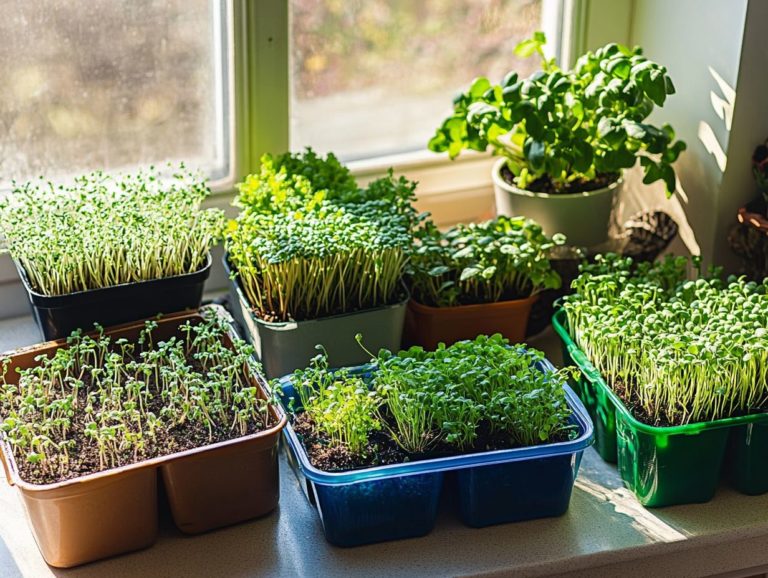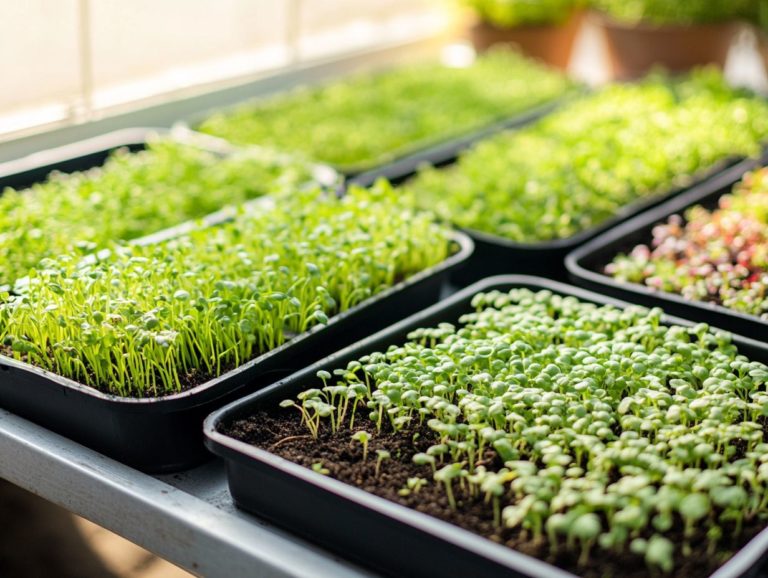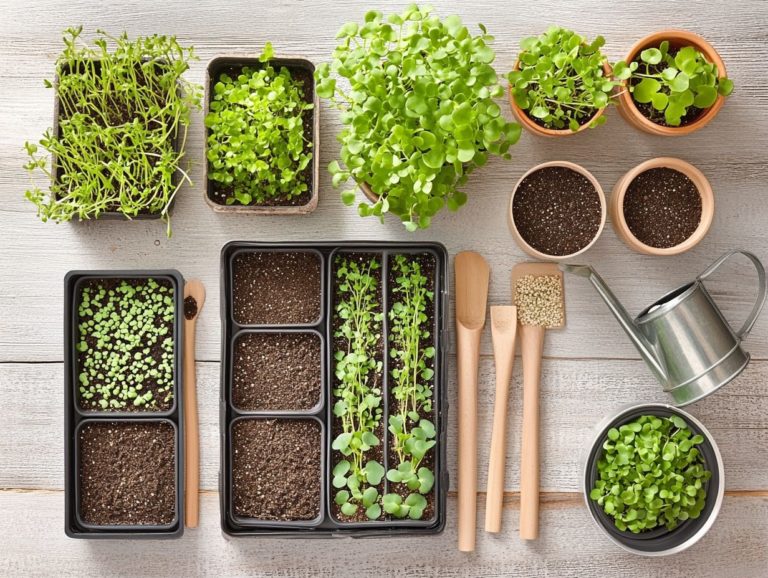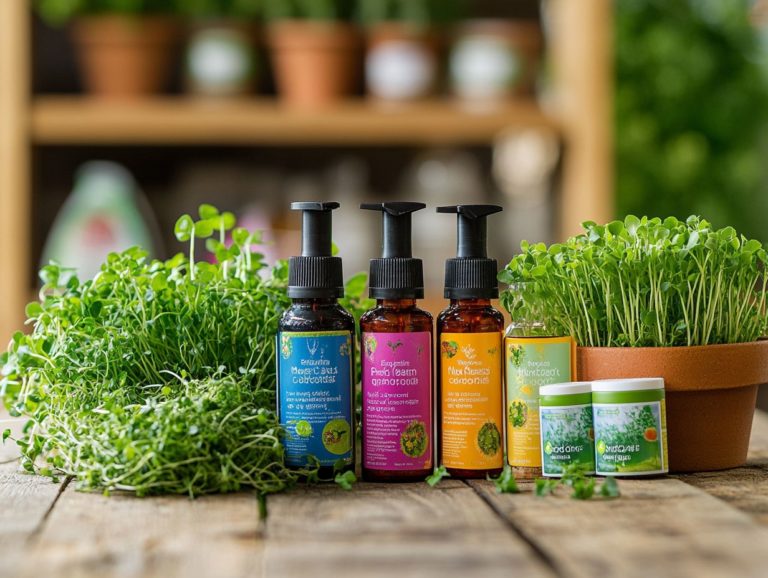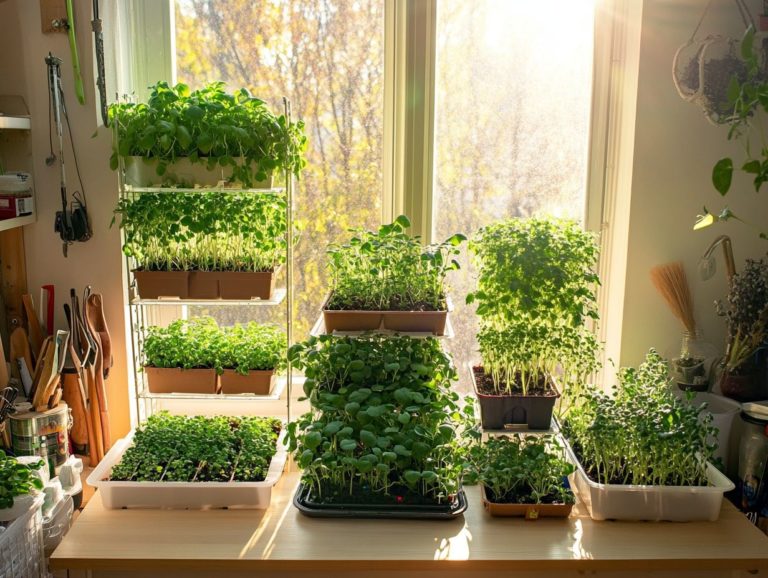Best Practices for Microgreen Seed Storage
Microgreens have truly revolutionized the culinary landscape, delivering an explosion of flavor and nutrition in delightfully tiny packages. However, the journey to your plate begins long before the harvest; proper seed storage is essential for achieving optimal results, especially if you want to store microgreens effectively.
This article delves into the myriad benefits of microgreens, highlighting their impressive nutritional profile and guiding you on how to select and store seeds with finesse. It also offers best practices for storage, outlines common pitfalls to avoid, and shares expert tips to prolong the viability of your seeds and keep harvested microgreens fresh.
Whether you’re a seasoned gardener or just dipping your toes into the world of gardening, grasping the nuances of microgreen seed care will set you on a path to success in your gardening endeavors.
Contents
- Key Takeaways:
- Benefits of Growing Microgreens
- Choosing and Storing Microgreen Seeds
- Best Practices for Seed Storage
- Common Mistakes to Avoid
- Tips for Maximizing Seed Viability
- Frequently Asked Questions
- What are the best practices for storing microgreen seeds?
- Why is it important to store microgreen seeds properly?
- How long can microgreen seeds be stored?
- Can I store different types of microgreen seeds together?
- What are the ideal conditions for storing microgreen seeds?
- Should I store microgreen seeds in the refrigerator?
Key Takeaways:
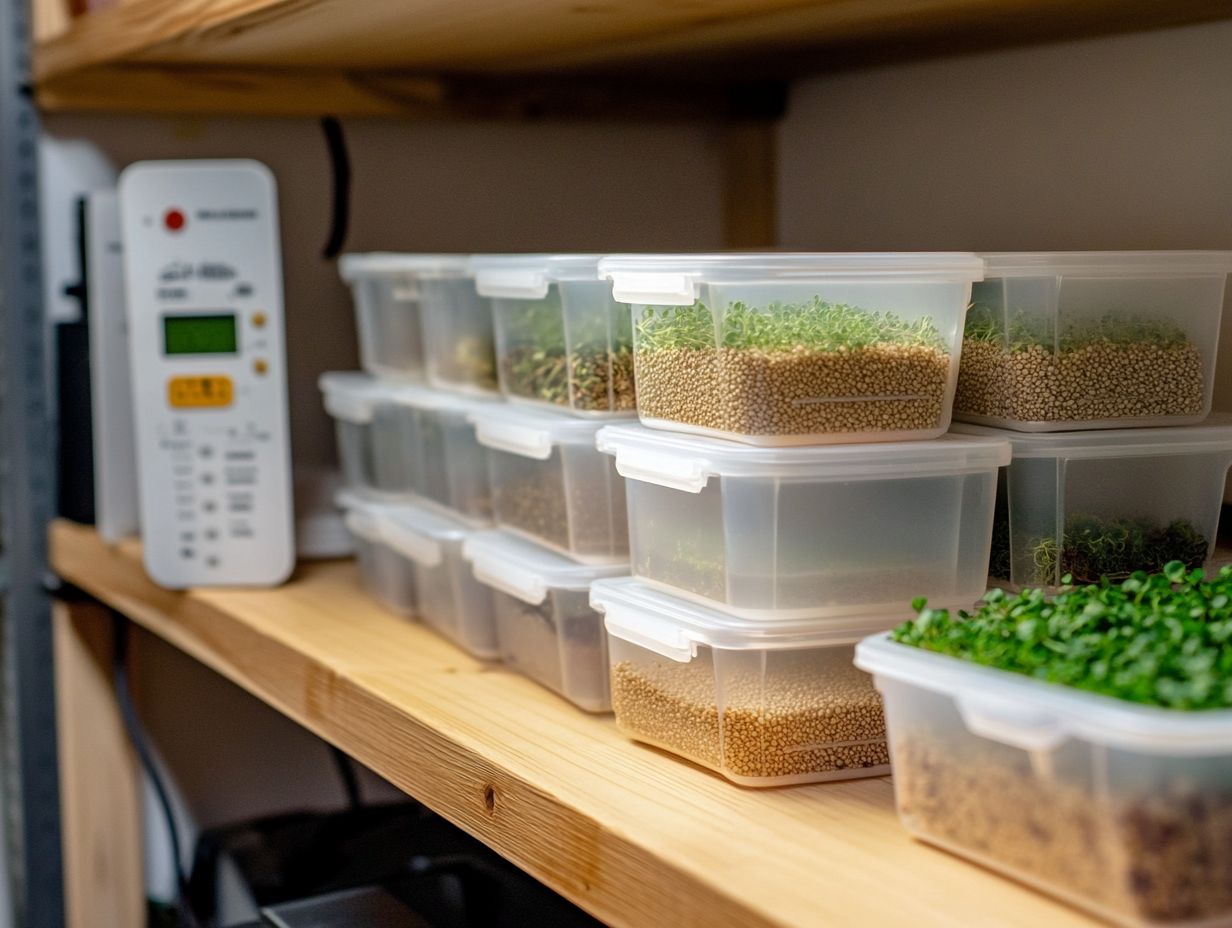
What are Microgreens?
Microgreens are your secret weapon in the kitchen young, edible plants harvested shortly after germination, typically between 7 to 21 days old. Their vibrant colors and intense flavors can elevate any dish. You can grow them from a variety of seeds, including broccoli, cabbage, kale, peas, sunflower, and radishes, adding versatility to your culinary creations. Not only do these nutrient-dense plants provide fresh ingredients, but they also offer a delightful gardening experience that enriches your cooking.
These tiny greens deliver a powerful nutritional punch, boasting vitamins, minerals, and antioxidants that outshine those found in their mature counterparts. The good news? The growing conditions for microgreens are incredibly straightforward; they thrive indoors or outdoors with enough light, making hydroponics a brilliant choice if you’re tight on space.
Regarding flavor, microgreens can range from peppery to sweet, enhancing everything from simple salads to gourmet dishes. Chefs often use them as garnishes or key ingredients, adding texture and vibrant colors that elevate meal presentations while also delivering essential nutrients.
Benefits of Growing Microgreens
Growing microgreens presents an array of compelling benefits, from remarkable freshness to exceptional nutritional value, along with versatile culinary applications that can elevate your meals.
These petite greens are bursting with flavor and are packed with vitamins and minerals often more concentrated than those found in their mature counterparts.
Additionally, they require minimal space and can thrive both indoors and outdoors, making them an accessible choice for gardeners of all skill levels, whether you’re just starting out or have years of experience under your belt.
Nutritional Value and Culinary Uses
Microgreens are a treasure trove of nutritional value, often packing higher concentrations of vitamins and minerals than their mature counterparts. Incorporating these vibrant greens into your diet is a game-changer.
Varieties such as broccoli, cabbage, kale, peas, sunflower, and radishes not only deliver exceptional health benefits but also elevate the flavor profiles of your salads, soups, sandwiches, and garnishes, opening the door to endless culinary creativity.
Take broccoli microgreens, for example; they are loaded with sulforaphane, a compound celebrated for its potential cancer-fighting properties. Kale microgreens, on the other hand, offer a wealth of vitamins A, C, and K, which are essential for supporting your immune system and promoting bone health.
Then there are the delightful pea shoots, whose delicate sweetness adds an unmistakable twist to your dishes, making them a go-to for chefs eager to enhance their menus.
Sunflower microgreens bring a nutty flavor that can transform your stir-fries or serve as a stunning topping for avocado toast, appealing to both the eyes and taste buds. And don’t overlook radish microgreens; their spicy kick is perfect for livening up sandwiches or salads, showcasing how these tiny greens can play a pivotal role in both nutrition and culinary artistry.
Choosing and Storing Microgreen Seeds

Selecting the right microgreen seeds and mastering their storage are essential for successful cultivation and maximizing the freshness of your harvested microgreens.
Consider factors such as moisture levels, seed types, and storage conditions to enhance seed viability and preserve their nutritional value.
Your understanding of seed storage can profoundly influence the overall yield and quality of your microgreens, ensuring they remain vibrant and bursting with flavor.
Factors to Consider
When selecting and storing microgreen seeds, you need to consider several factors to ensure optimal growth and longevity. Think about moisture levels, temperature, exposure to a gas that can affect ripening, and air flow.
Managing these elements properly can prevent seed spoilage and enhance the effectiveness of your storage process.
Using small packets that absorb moisture is a smart move! Understanding the temperature needs of different seeds will further aid your success in cultivating microgreens, especially when storing microgreens for maximum freshness in a refrigerator or freezer to prolong their lifespan.
It’s also essential to keep an eye on air flow in your storage environment. Stagnant air can lead to moisture buildup, promoting mold and decay. Encouraging air circulation helps maintain stable conditions and reduces harmful ethylene levels that can compromise seed vitality.
Storing your seeds in a cool, dark place away from direct sunlight will protect them from temperature fluctuations.
Considering these factors can greatly extend the viability and effectiveness of your microgreen seeds over time, especially when you apply tips for freshness, creating a flourishing growing environment!
Best Practices for Seed Storage
Implementing best practices for seed storage is crucial for prolonging the shelf life of your microgreen seeds and ensuring successful growth once they re planted. Proper storage in a controlled environment, like the refrigerator or freezer, is vital to safeguard them from moisture and temperature fluctuations.
By choosing the right containers, such as airtight jars, you can significantly enhance the longevity of your seeds. For more information on proper storage, check out how to store different microgreen varieties. Store them properly and enjoy fresh microgreens whenever you want!
Proper Storage Techniques
Applying proper storage techniques is essential for maintaining the quality and viability of your microgreen seeds, ensuring they stay fresh and ready for planting when you need them. This means using a sharp knife for cutting, handling the seeds with care, and employing paper towels to manage any excess moisture.
Storing your seeds in a cool, dry place can significantly extend their lifespan, as temperature fluctuations can cause degradation. Investing in airtight containers is a smart move, protecting your seeds from light and humidity, two factors that can diminish their potency. For those growing microgreens, learning the best methods for storing microgreens can also enhance their freshness and quality.
By regularly checking for signs of spoilage, you ensure that only the healthiest seeds make it to your planting tray, setting the stage for successful growth. Proper storage not only preserves the seeds but also elevates the overall quality of your microgreens, paving the way for a bountiful harvest! For those interested in enhancing their growing techniques, exploring the best practices for watering microgreens can be incredibly beneficial.
Common Mistakes to Avoid
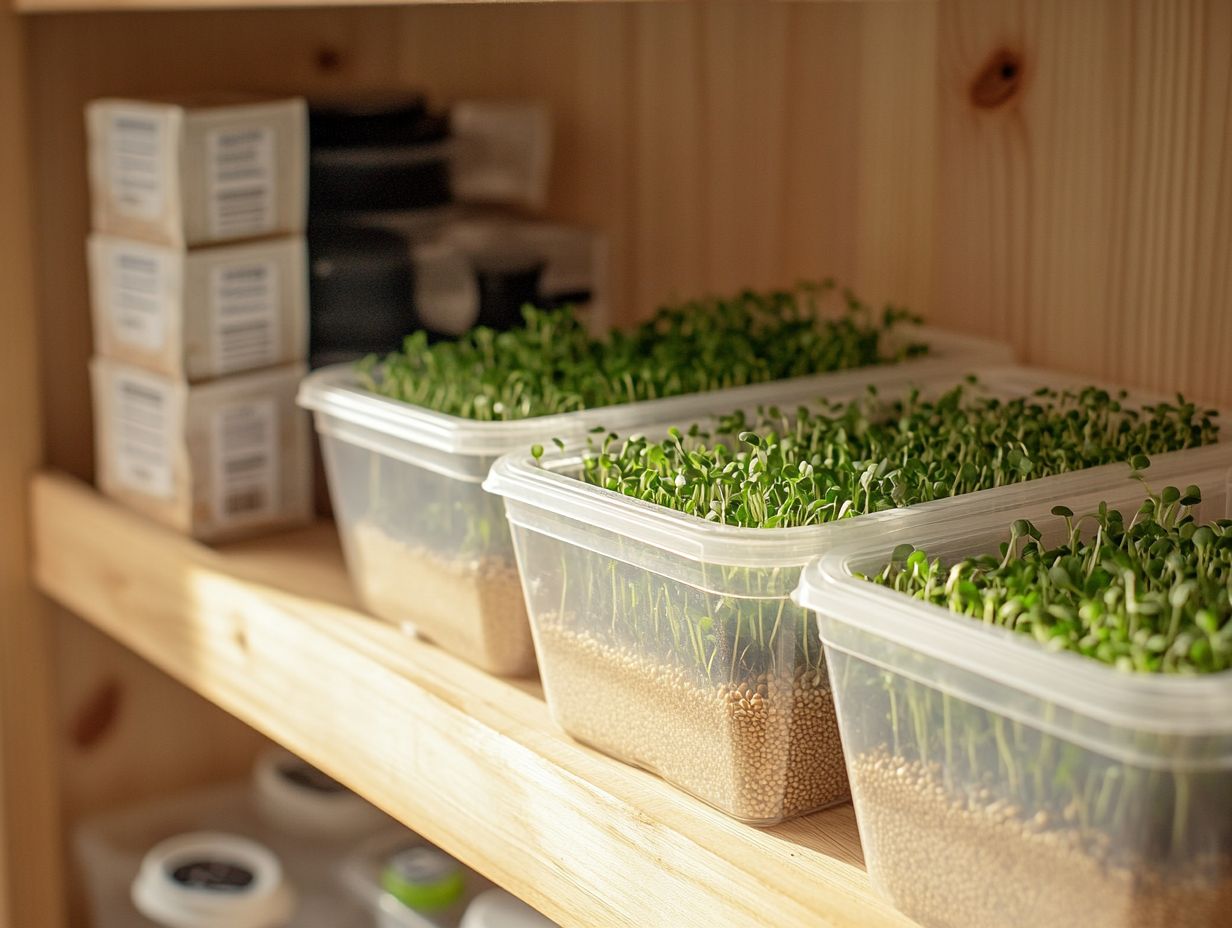
Avoiding common mistakes in the storage and handling of microgreen seeds is essential for preventing spoilage and ensuring a bountiful harvest. Factors such as moisture levels and exposure to ethylene can dramatically impact seed viability, potentially leading to underwhelming results.
By being aware of these pitfalls, you can take proactive steps to safeguard your seeds and optimize their storage conditions ultimately setting the stage for the best possible outcomes!
How to Prevent Seed Spoilage
Preventing seed spoilage is crucial for maintaining the quality and viability of your microgreens. It requires careful attention to moisture levels, a gas that can cause spoilage, and airflow conditions.
Using substances that absorb moisture can significantly aid in managing humidity. Ensuring good air circulation is essential for preventing mold growth and decay.
By implementing these strategies, you can safeguard the health of your microgreen seeds and set the stage for a successful growing experience.
Monitoring your storage environment is key. Keeping seeds in a cool, dry place helps inhibit the growth of mold and harmful bacteria.
Effective ethylene management is equally vital, as this gas can accelerate ripening and spoilage. Utilizing ethylene-absorbing packets or ventilation systems can greatly enhance the longevity of your seeds.
Regularly checking for signs of spoilage will allow you to catch potential issues early. This ensures that only the highest quality seeds are used for planting.
Together, these strategies create an optimal environment for seed storage, fostering healthier microgreen production.
Tips for Maximizing Seed Viability
Maximizing seed viability for microgreens is crucial for achieving a fruitful harvest. Several strategies can extend the shelf life of your seeds.
Store seeds in optimal containers, incorporate desiccant packets to manage humidity, and maintain an ideal temperature. These practices safeguard your investment and elevate your growing experience.
They ensure that your seeds germinate effortlessly and flourish beautifully.
Tips to Extend the Shelf Life of Microgreen Seeds
To extend the shelf life of your microgreen seeds, store them in controlled environments like the refrigerator or freezer. Pair this with desiccant packets to manage humidity.
Keeping the seeds in airtight containers and away from direct light significantly enhances their viability over time.
By adhering to these guidelines, you can relish fresh microgreens whenever you desire, free from concerns about seed quality or loss.
For optimal results, pay close attention to the temperature during storage. Fluctuations can adversely impact germination rates.
A consistent, cool environment minimizes the risk of mold and decay, further promoting longevity.
Incorporating moisture-absorbing materials, such as silica gel or activated charcoal, will effectively regulate humidity levels. This ensures your seeds remain dry and in prime condition.
A well-structured approach to seed storage not only prolongs their shelf life but also guarantees that each planting yields vibrant, healthy microgreens, ready to elevate any dish you create.
Frequently Asked Questions
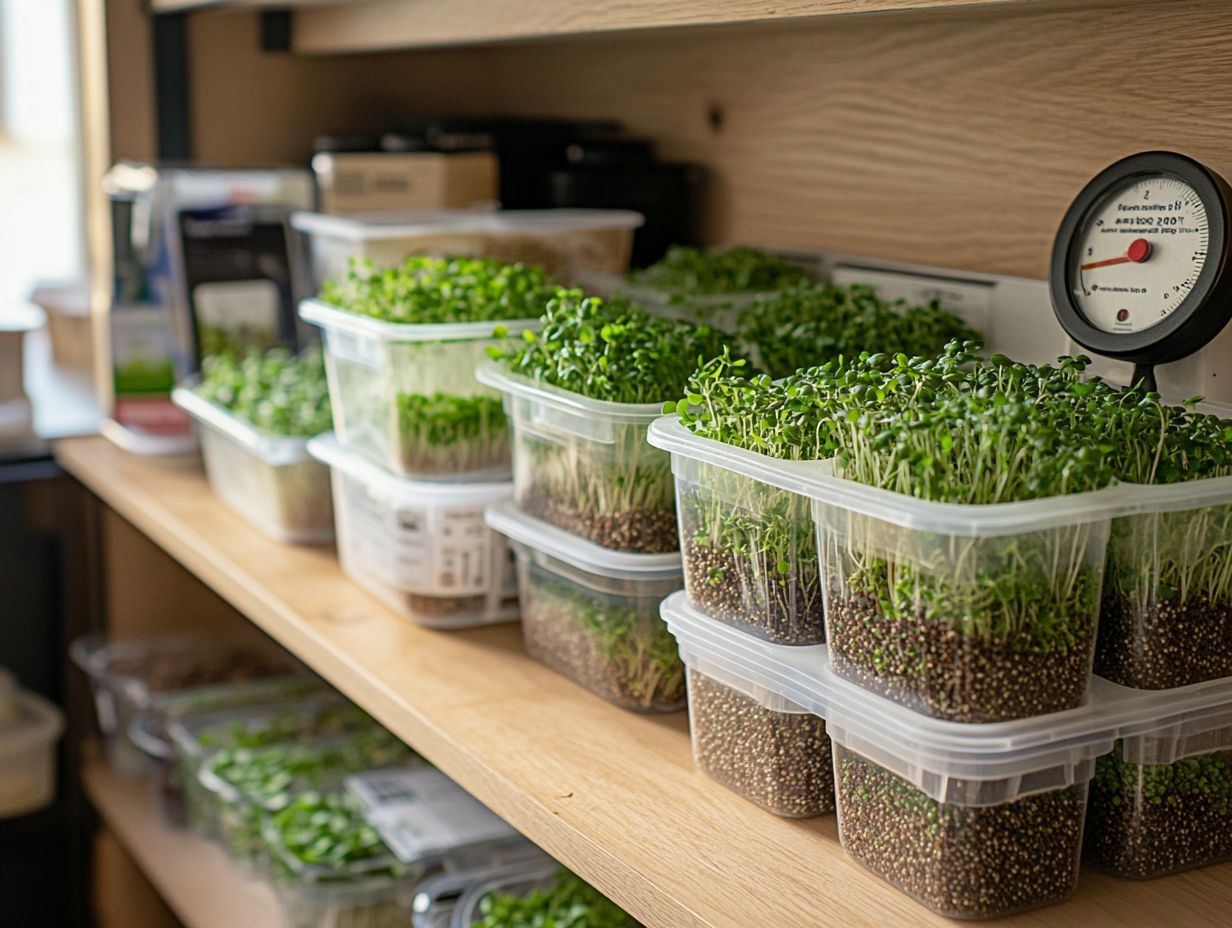
What are the best practices for storing microgreen seeds?
The best practices for storing microgreen seeds include keeping them in a cool and dry place, using airtight containers, and storing them away from direct sunlight.
Why is it important to store microgreen seeds properly?
Storing your microgreen seeds properly means they’ll sprout and grow beautifully! This leads to a successful harvest of healthy and flavorful microgreens.
How long can microgreen seeds be stored?
On average, microgreen seeds can be stored for up to 3 years if they are properly stored in ideal conditions. However, it is recommended to use them within 1-2 years for best results.
Can I store different types of microgreen seeds together?
It is not recommended to store different types of microgreen seeds together, as they have different ideal storage conditions and may cross-contaminate each other.
What are the ideal conditions for storing microgreen seeds?
The ideal conditions for storing microgreen seeds include a temperature range of 40-50 degrees Fahrenheit, low humidity levels, and protection from light and moisture.
Should I store microgreen seeds in the refrigerator?
While refrigeration can help prolong the shelf life of microgreen seeds, it is not recommended. The temperature and humidity levels in a fridge can fluctuate, potentially damaging the seeds. It is best to store them in a cool, dry place instead.
Start your microgreen journey today for fresh flavors in your meals!

